BRIEF HISTORY OF THE RICKMANSORTH CHURCH STREET BRANCH AND STATION
The Watford & Rickmansworth Railway was initially promoted by former Middlesex MP (as Robert Grosvenor) Lord Ebury, a local landowner with a magnificent country residence at Moor Park. He saw it as a way to connect the newly-opened GWR Uxbridge branch with the LNWR at Watford. In July 1860 he obtained powers to construct a 4½-mile single-track line between Watford and Rickmansworth and immediately submitted a further Bill to construct an extension from Rickmansworth to Uxbridge.
 |
Lord Ebury eventually hoped to complete a wider scheme by providing a cross-country route from Watford to Hertford with possible connections to the Midland, Great Northern and Great Eastern Railways. Although this route would be of some benefit to passengers it would have been of more value as a freight route to transfer goods from one company to |
another without the need to go into London. It was hoped the scheme would bring economic development and prosperity to the area and was welcomed by the people of Uxbridge and Rickmansworth who would benefit from improved communications.
Construction began near Moor Park on 22 November 1860 and the line opened on 1 October 1862, and although there was no official ceremony on the opening day a crowd of local people gathered to welcome the railway to their town. The original station was a basic timber construction reported to be ‘flimsy and leaky’. Just beyond the station the line crossed the Grand Junction Canal (Grand Union Canal from 1928). The W&RR Act had stipulated that the bridge should be ‘good and substantial’ and ‘at least ten feet above the top water level’.
Very little early documentation about the construction of the line has survived apart from an assessment of the general safety of the line written by the Board of Trade inspector on 1 September 1862; it was commissioned by the LNWR who would be running the line. The inspector criticised the siting of Watford (High Street) station because of poor visibility in both directions and noted that in his view, the station at Rickmansworth was “not ready”. He recommended a longer length of track between the end of the loop and the buffers and criticised the lack of a goods shed, a loading dock for a horse and carriage and adequate coal handling facilities. On three occasions the Board of Trade inspector, Col. Yolland, refused to sanction the opening of the line. It is unlikely these recommendations were implemented before the line opened a month later but the LNWR carried out sufficient work to enable the line to be opened. The OS 1:2,500 map for 1873 does show a goods shed and loading dock.
The Rickmansworth terminus was located opposite the church to the south of the town where interchange sidings were provided with the nearby Grand Junction Canal. The line ran from the LNWR at Watford Junction with one intermediate station at Watford High Street. Initially there were five trains in each direction on weekdays. The push-pull two-coach trains were hauled by 0-6-2 tank locomotives.
The goods yard was on the north side of the station and initially comprised three sidings. Two sidings ran in parallel, one running into a small goods shed while the other ran past a loading dock (identified on some plans as a horse and carriage landing) terminating alongside the goods shed. The third short siding, immediately behind the platform, terminated end-on to the dock. By 1898 four more sidings had been added, fanning out across the yard to the north of the goods shed. There was also a 1 ton 10 cwt yard crane.
| The Rickmansworth branch of the Grand Junction Canal (a canalised section of the River Chess) was opened up to the Town Wharf early in the 19th century. The Chess Lock, which was built in 1804, allowed boats to reach the wharf from Batchworth Junction on the Grand Junction Canal. Various businesses were served by it, including Salter's |
 |
Brewery and the gas works.Work on a new transhipment wharf and canal basin on the south side of the station started in 1912. This was served by two sidings which were accessed from the run-round loop. One of the cargoes to pass over it was sheet asbestos coming up from Harefield, and cement from the same area was likely to be another.
The entrance to the yard was from Church Street in the north-west corner. Once inside the yard there was a weighbridge and office with coal merchants’ offices to the right, backing onto Church Street, and a small stable yard to the left. Goods traffic to Rickmansworth was of a general nature although coal, building materials and milk formed a considerable proportion of the total goods carried.
Despite hopes that the railway would bring further economic development to Rickmansworth and would serve the small factories and warehouses which had developed along the Grand Junction Canal; it was Watford which actually grew at a faster pace and drew business from Rickmansworth. The construction of the railway was dogged with financial problems, and a further Act of Parliament had to be passed in 1863 to authorise the issue of further shares to the value of £30,000 (£40,000 worth of shares had already been issued). The line was worked from the outset by the London & North Western Railway (LNWR) who paid the WRR 50% of the gross earnings of the line. The same financial difficulties halted the progress of the Uxbridge extension and, despite 11 Acts of Parliament promoted by three separate companies over a 40-year period, this and Lord Ebury's other railway projects were never built.
 |
The railway was never particularly financially successful, and the Official Receiver was called in only four years after opening. Attempts had been made to remedy their financial problems by opening several freight branches, the most notable being to the Croxley printers and to the Grand Junction Canal at Croxley Green. The carriage of watercress also developed, and it became a common sight to see hampers being transported to the market at Watford - and stock used on the branch gained the nickname ‘watercress trains’. By 1881 the local company was bankrupt and the burgeoning LNWR whose station it shared at Watford Junction acquired all the shares and wrote off the debts of the W & R but no money actually changed hands. Following absorption by the LNWR little initially changed and in 1887 the line boasted 15 daily services from Rickmansworth to Watford and 16 in the reverse direction. Two services in each direction were through trains to or from London Euston, via Watford Junction.
 |
A scheme to electrify services between London and Watford was first suggested in 1907. Worried by the growing influence of the Metropolitan Railway in north-west London, the LNWR added a short branch line to Croxley Green under the New Lines Act. Works commenced in 1908 and the new route opened on 15 June 1912. The short 1¼-mile Croxley Green branch |
Rickmansworth line at Croxley Green Junction which was substantially rebuilt as a double-track formation forming part of the LNWR’s ambitious London suburban electrification scheme which was announced in 1911 after the LNWR took over the North London Railway. As part of this scheme a new suburban line would diverge from the main line at Bushey & Oxhey and in a wide sweep cross the Colne Valley to a junction with the Rickmansworth line 250yd south west of Watford High Street station. This was opened for steam operation on 10 February 1913, with electric trains operating from 16 April 1917.
The construction of the new lines in the Watford area included a triangular junction with a spur enabling trains from Croxley Green or Rickmansworth to run south to Bushey and on to London, although, in practice, this service only ever ran from Croxley Green. The western end of the curve retained the name Croxley Green Junction and included the junction with the Croxley Green branch.The eastern end of the Croxley Green Curve was known as Colne Junction. Adjacent to Croxley Green Junction a substantial new depot, known as Croxley Green sheds, was built to house the new electric trains.
| Electric trains of Oerlikon saloon stock replaced steam on the Croxley Green branch on 30 October 1922. This marked the final stage of the LNWR’s London suburban electrification, just two months before the LNWR became part of the London Midland & Scottish (LMS) Railway on 1 January 1923. Although it was always intended that the Rickmansworth branch |
 |
would be electrified as part of the North Western Electrics scheme it had to wait until September 1927 when it was electrified by the LMS using an existing sub-station at Bushey.
In 1921/2 the wooden station at Rickmansworth was replaced with a brick building under a hipped slate roof, whose small entrance porch opened onto the forecourt. On entering the booking hall, the booking office was straight head with the stationmaster’s office to its left and the parcels office to its right; another door led onto the platform. Rooms reached from the platform were, from west to east: booking hall, parcels office, ladies’ waiting room, general (sometimes referred to as gentlemen’s) waiting room, gents’ toilet and lamp/porters’ room. A wide upward-sloping canopy gave protection from the weather. Rickmansworth had no signal box; initially points were operated by individual levers, but in the 1920s a ground frame was provided on the platform at the east end of the station building but in later years access to the goods yard was controlled by a frame on the west side of the Grand Junction Canal bridge.
 |
During the 1930s London tube stock was used on the Rickmansworth branch. Joint LNWR/London Electric Railway (Underground Group) tube stock had been running on the Watford Junction to Elephant & Castle (Bakerloo line) service from 29 March 1920. They were found to be slow in traffic and were eventually replaced by standard underground stock. Nine of the |
72 joint cars were transferred to the Croxley Green and Rickmansworth branches because the full size electric cars used on both branches were putting an excessive load on the Bushey sub-station. For most of the 1930s the service on the Rickmansworth branch was provided by tube stock, although until 1938 normal (full size) stock was used on Saturdays to cope with heavier traffic needs, including shoppers. The tube fitted with luggage compartments which were decribed as 'very inconvenient for carrying boxes of watercress' which was still a regular cargo on the line.
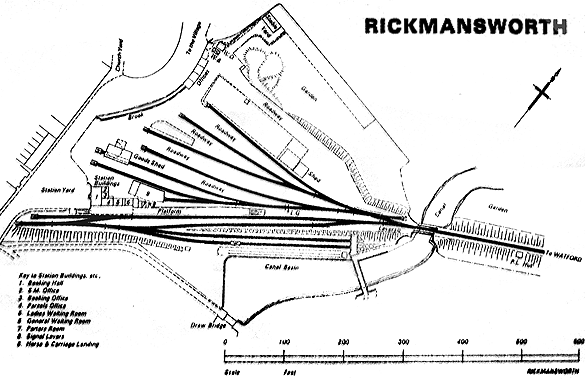 |
In 1922 there were 13 down trains in each direction with 16 on Saturdays. The additional Saturday trains comprised one in the afternoon and two in the evening. During the 1920s competition from local bus services led to a decline in passenger numbers. In 1921 the Rickmansworth & District Omnibus Company began operating services to Watford. Although this company did not last long it was replaced by the National Omnibus & Transport Company who extended their service from Croxley Green to Rickmansworth in 1924. The Lewis Omnibus Company followed, operating from Rickmansworth to Watford and St Albans. This company also took over the Metropolitan bus service from Watford Metropolitan station to the town centre.
| The opening of the Metropolitan line from Watford via Croxley to Rickmansworth on 2 November 1925 also led to a further decline in passenger numbers. The Rickmansworth branch found it difficult to compete with the new line with 35 Met electric trains a day running into Baker Street (and Aldgate in peak hours) plus the same number of steam trains running to and |
 |
from Marylebone.
In 1939 the tube stock was withdrawn and replaced with spare main line stock; these were Oerlikon saloon cars which were used on the branch until closure.
At nationalisation in January 1948, the Rickmansworth branch became part of British Railways’ London Midland Region. The goods station was renamed Rickmansworth (Church Street) on 1 July 1950 to avoid confusion with the main line station, and the goods station followed suit on 25 September 1950. The passenger station was fitted with BR totem signs carrying the new name.
In 1950 there were 20 down trains in each direction on weekdays and 34 on Saturdays in each direction. There were also 15 trains in each direction on Sundays. Despite this intensive service, the station’s days were numbered. The last passenger train ran on Sunday 2 March 1952, and the last train at 10.45pm carried a dozen or so enthusiasts and one genuine passenger.
 |
The Autumn 1952 issue of Hertfordshire Countryside reported the closure. ‘After the customary attempts at postponement, representations by Mr Gilbert Longden, MP for South West Hertfordshire, and “careful consideration” by the Railway Executive, Sunday 2 March 1952 saw the demise of the former Watford and Rickmansworth |
Railway in the departure of the last train from Rickmansworth for Watford Junction. There was an air of pathos about the immaculately kept and newly decorated little station, only recently dignified by the full title of “Rickmansworth Church Street” on bright new boards, to avoid the confusions of two stations of the same name under one nationalized concern.’
‘As the train shuttled to and fro on its final errands, many made the 10 minute journey just for old times’ sake, briefly to experience for the last time carriage window glimpses of Colne, Chess, Gade and Grand Union Canal, Croxley Common Moor, and the tree-clad slopes of Moor Park. The final closing was unattended by any ceremony, A dozen or so loyal railway enthusiasts disembarked at Church Street and ruefully surveyed the gas-lit scene. A few minutes later they rejoined the train and the lights of old “Ricky” were quickly left behind. Crossing the canal, the train gathered speed up Tolpits Lane, passed Brightwell Farm, and rattled downhill to the Croxley Green Junction, pausing for the staff to be handed up to the box for the last time from a passenger train. “A quiet funeral” as one bereaved enthusiast remarked.’
| The branch remained open for goods traffic, with occasional workings to the sidings at Croxley Mills and the Universal Asbestos Factory. At Brightwell’s Farm another siding led to exchange sidings for the Colne Valley Water Company to connect with a 2ft narrow gauge railway built in 1932. Near Watford High Street station another siding served Benskin’s Brewery. The |
 |
last rail despatch of beer left in 1953, although barley was delivered by rail until 1956. Rickmansworth Church Street station remained open for goods traffic until 2 January 1967, although a private siding stayed open for a short time after that date. Once that closed, the branch was cut back to Croxley Mill sidings. The line finally closed west of Croxley Green Junction in 1983 when the siding into Croxley Paper Mill was closed.
In 1967 the station building was occupied by a printing firm. After track-lifting in late 1967 the station remained intact until about 1973/1974 when the site was cleared for new housing. Most of the route from the bridge over the canal just to the east of the station now forms part of the Ebury Trail footpath and cycleway up to the junction with the Croxley Green branch.
The Route: From Watford High Street Junction (TQ111957) it headed SW passing under Wiggenhall Road (A4178) to reach Croxley Green Junction where the line from Bushey trailed in (forming a triangular junction) and the Croxley Green branch diverged west. From there it followed the Colne Valley and after bridging the River Colne and its branches three times in quick succession turned west to pass under Tolpits Lane (A4145). Over the last mile it passed under the Met/GCR joint line, bridged the Grand Union Canal and finally the River Chess beyond which lines fanned out to the coal yard and the single platform Church Street terminus (TQ062941)
Tickets from Michael Stewart. Route map drawn by Alan Young. Bradshaw from Chris Totty
Special thanks to Les Mead from the Three Rivers Museum, Fabian Hiscock from the Rickmansworth Waterways Trust, Lynda Bullock from the West Watford History Group and David Pearson for help in compiling this feature.
Sources:
See also Watford High Street & Colne Valley Waterworks Railway
See also Croxley Green triangular junction and depot
To see stations on the Croxley Green branch click on the station name: Croxley Green, Watford Stadium, Watford West & Watford High Street
|

old1.jpg)
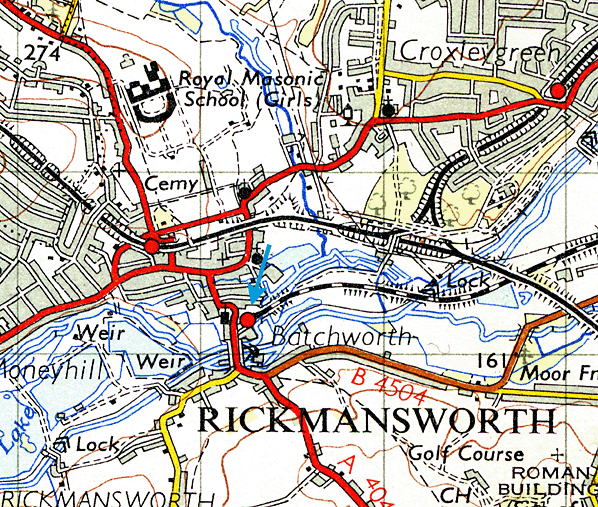
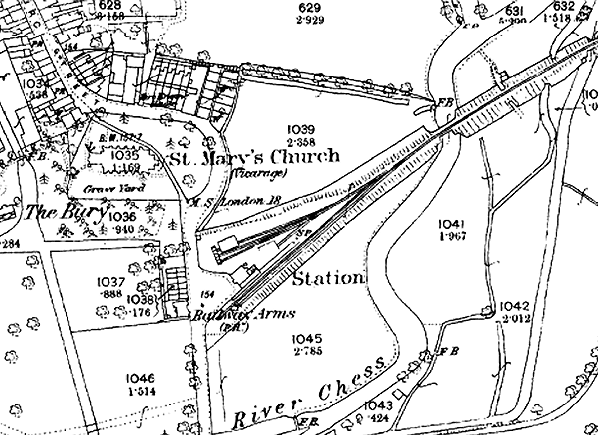
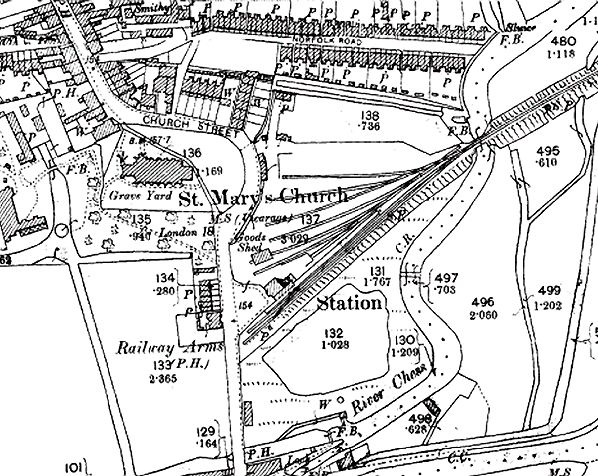
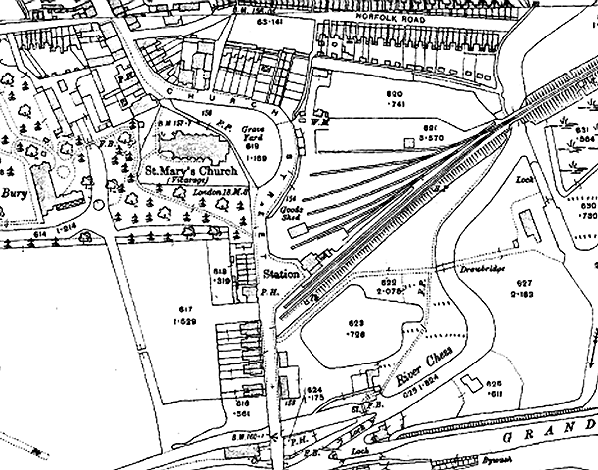
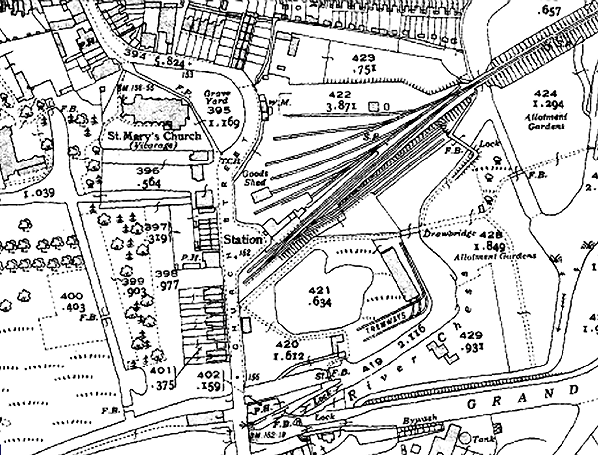
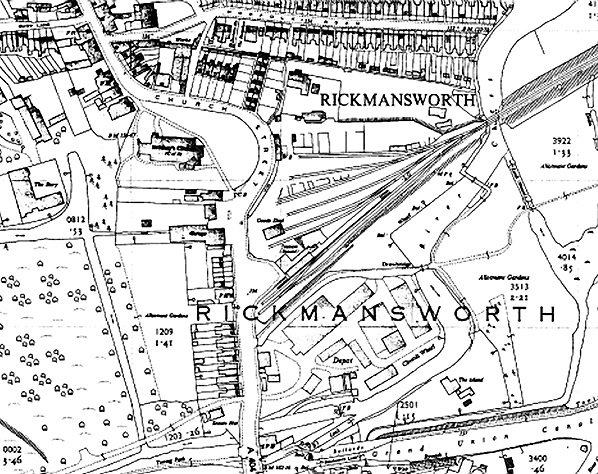
old15.jpg)
old13.jpg)
old8.jpg)
old4.jpg)
old16.jpg)
old21.jpg)
6.jpg)
1.jpg)
4.jpg)
12.jpg)
8.jpg)
church_street18.jpg)




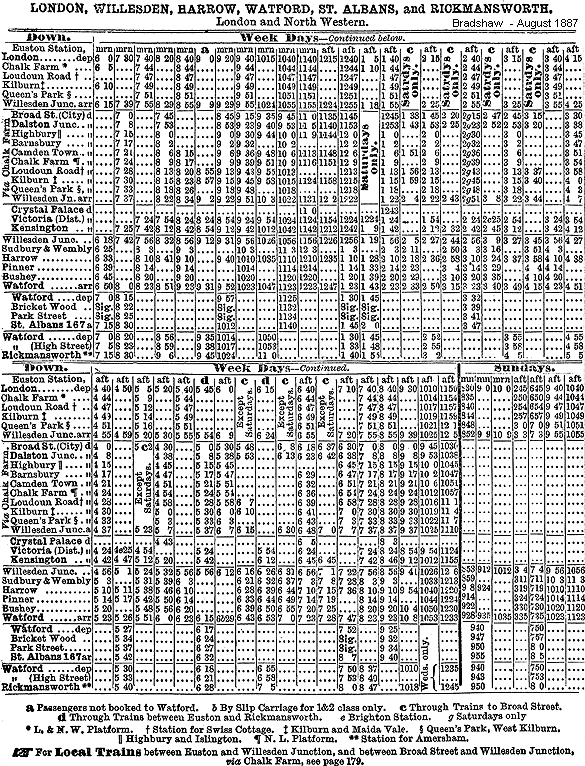







 Home Page
Home Page